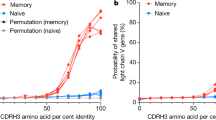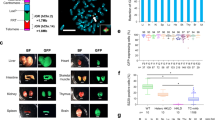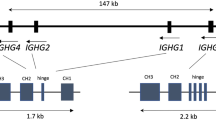Abstract
The major histocompatibility complex (MHC) in man, also called the HLA region, is located on the short arm of chromosome 6 and encodes antigens involved in immunological processes1. The class II HLA antigens consist of two noncovalently associated polypeptide chains, one of molecular weight 34,000 (α) and the other of molecular weight 29,000 (β)2. The extensive polymorphism of the β chain(s) has allowed the genetic mapping of the corresponding β gene(s) to the HLA-DR region3–5. cDNA clones for the HLA-DR α chain have been used to map the non-polymorphic DR α-chain gene to chromosome 6 using mouse–human somatic cell hybrids6. Similarly, the DR α-chain gene7 has been mapped to the short arm of chromosome 6 centromeric to the HLA-A, -B and -C loci by in situ hybridization experiments8. We isolated a cDNA clone that is related to the DR α chain and encodes the class II antigen DC α chain9. We describe here how this DC α clone was used to find two or three additional α-chain genes by cross-hybridization and how HLA-antigen loss mutants of a human lymphoblastoid cell line (LCL) were used to ascertain that these additional class II antigen α-chain genes are also located in the HLA region.
This is a preview of subscription content, access via your institution
Access options
Subscribe to this journal
Receive 51 print issues and online access
$199.00 per year
only $3.90 per issue
Buy this article
- Purchase on Springer Link
- Instant access to full article PDF
Prices may be subject to local taxes which are calculated during checkout
Similar content being viewed by others
References
Klein, J. Science 203, 516–521 (1979).
Strominger, J. L. et al. in The Role of the Major Histocompatibility Complex in Immunology (ed. Dorf, M. E.) 115–172 (Garland, New York, 1981).
Kaufman, J. F., Andersen, R. L. & Strominger, J. L. J. exp. Med. 152, 37s–53s (1980).
Charron, D. J. & McDevitt, H. O. J. exp. Med. 152, 18s–36s (1980).
Corte, G., Damiani, G., Calabi, F., Fabbi, M. & Bargellesi, A. Proc. natn. Acad. Sci. U.S.A. 78, 534–538 (1981).
Lee, J. S., Trowsdale, J. & Bodmer, W. Proc. natn. Acad. Sci. U.S.A. 79, 545–549 (1982).
Korman, A. J., Auffray, C., Schamboeck, A. & Strominger, J. L. Proc. natn. Acad. Sci. U.S.A. 79, 6013–6017 (1982).
Kirsch, I. R. et al. Nature (submitted).
Auffray, C., Korman, A. J., Roux-Dosseto, M., Bono, R. & Strominger, J. L. Proc. natn. Acad. Sci. U.S.A. 79, 6337–6341 (1982).
Shackelford, D., Mann, D. L., van Rood, J. J., Ferrara, G. B. & Strominger, J. L. Proc. natn. Acad. Sci. U.S.A. 78, 4566–4570 (1981).
Kavathas, P., Bach, F. H. & De Mars, R. Proc. natn. Acad. Sci. U.S.A. 77, 4251–4255 (1980).
Kavathas, P., DeMars, R. & Bach, F. H. Hum. Immun. 4, 317–324 (1980).
DeMars, R. Chang, C. C. & Rudersdorf, R. Hum. Immun. (in the press).
DeMars, R. et al. J. Immun. (in the press).
Shaw, S. et al. J. exp. Med. 156, 731–743 (1982).
Auffray, C. et al. EMBO J. 2, 121–124 (1983).
Shaw, S., Johnson, A. H. & Shearer, G. M. J. exp. Med. 152, 565–580 (1980).
Shaw, S., Kavathas, P., Pollack, S., Charmot, D. & Mawas, C. Nature 293, 745–747 (1981).
Kavathas, P., DeMars, R., Bach, F. H. & Shaw, S. Nature 293, 747–748 (1981).
Katovitch-Hurley, C., Shaw, S., Nadler, L., Schlossman, S. & Capra, J. D. J. exp. Med. 156, 1557–1562 (1982).
Steinmetz, M. et al. Nature 300, 35–42 (1982).
Benoist, C. O., Mathis, D. J., Kanter, M. R., Williams, V. E. & McDevitt, H. O. Proc. natn. Acad. Sci. U.S.A. 80, 534–538 (1983).
Larhammar, D. et al. Proc. natn. Acad. Sci. U.S.A. 79, 3687–3691 (1982).
Long, E. O. et al. Proc. natn. Acad. Sci. U.S.A. 79, 7465–7469 (1982).
Orr, H. T. et al. Nature 296, 454–456 (1982).
Orr, H. T. & DeMars, R. Nature 302, 534–536 (1983).
Vogelstein, B. & Gillepsie, D. Proc. natn. Acad. Sci. U.S.A. 76, 615–619 (1979).
Blin, N. & Stafford, W. Nucleic Acids Res. 3, 2303–2308 (1976).
Southern, E. M. J. molec. Biol. 98, 503–517 (1975).
Rigby, P. W. J., Diekmann, M., Rhodes, C. & Berg, P. J. molec. Biol. 113, 237–251 (1977).
Author information
Authors and Affiliations
Rights and permissions
About this article
Cite this article
Auffray, C., Kuo, J., DeMars, R. et al. A minimum of four human class II α-chain genes are encoded in the HLA region of chromosome 6. Nature 304, 174–177 (1983). https://doi.org/10.1038/304174a0
Received:
Accepted:
Issue Date:
DOI: https://doi.org/10.1038/304174a0
This article is cited by
-
Trans-species evolution of Mhc-DRB haplotype polymorphism in primates: Organization of DRB genes in the chimpanzee
Immunogenetics (1992)
-
Structure and expression of HLA-DQ ? and -DX ? genes: interallelic alternate splicing of the HLA-DQ ? gene and functional splicing of the HLA-DX ? gene using a retroviral vector
Immunogenetics (1987)
-
Molecular Diversity of HLA-DQ
Immunogenetics (1987)
-
The immune system and lymphoma
La Ricerca in Clinica e in Laboratorio (1987)
-
New HLA DNA polymorphisms associated with autoimmune diseases
Nature (1986)
Comments
By submitting a comment you agree to abide by our Terms and Community Guidelines. If you find something abusive or that does not comply with our terms or guidelines please flag it as inappropriate.



